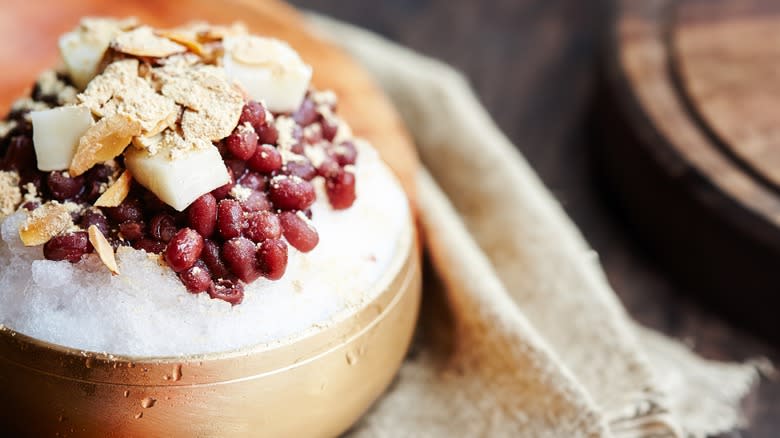Bingsu Is The Creamy Korean Shaved Ice You Should Know

In Western cultures, shaved ice is a simple and refreshing summer treat consisting of fluffy balls of finely crushed ice saturated with brightly colored fruit syrups. They're a lighter, ice-based alternative to milk-based treats like ice cream and frozen yogurt. Bingsu, on the other hand, is the creamy, utterly decadent Korean version of shaved ice that'll force you to abandon all preconceived notions of what shaved ice can be.
You can think of bingsu as the sundae of the shaved ice world: A shareable dessert that uses pillowy, milk-based shaved ice as a foundation for syrups, pastes, and toppings of all kinds. Traditional bingsu, or patbingsu, consists of shaved milk-ice drizzled with condensed milk and topped with a sweet red bean paste. The sweetened condensed milk and milk-based ice create an ultra-creamy, ultra-fluffy consistency. Red bean paste is a common ingredient in Asian desserts, usually stuffed inside of buns, cakes, or mochi.
Bingsu stands and cafes are summer hotspots, with massive menus that are as customizable as ice cream or frozen yogurt shops. You can add any number of syrups, candies, chocolates, fruits, or even scoops of ice cream to the standard milk-infused ice base. Furthermore, shops now blend the shaved ice with flavored milky mixtures like sesame, coffee, matcha, and chocolate.
Read more: 25 Best Ice Cream Brands Ranked
The History And Cultural Influences Of Bingsu

Originating in the late 19th and early 20th centuries during the Joseon Dynasty, bingsu was initially a simple shaved ice and chopped fruit dessert enjoyed only by the upper echelons. However, by the time iceboxes became a ubiquitous appliance in the 1920s, bingsu shops began to emerge all around South Korea's capital city of Seoul.
It was also during this time that bingsu began to be paired with other popular dessert ingredients like grain powder, rice cakes, and red bean paste. The Korean War led to further diversification of bingsu's traditional recipe as contact with Japan, China, and the Western world introduced Korean palates to sweetened condensed milk, processed candies, fruit syrups, and whipped cream.
Red bean patbingsu remains a mainstay on modern menus along with chopped fresh fruit garnishes — mango and fresh berries are the top sellers. Bingsu has also become a prepackaged product sold at convenience stores and offered through food-delivery apps. Even fine-dining restaurants in ritzy hotels serve bingsu, impressing guests with globally inspired elaborations like tiramisu bingsu, cheesecake bingsu, and green tea-infused bingsu.
Read the original article on Tasting Table.

 Yahoo Sports
Yahoo Sports 